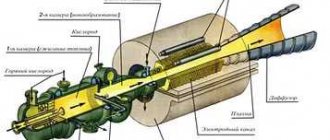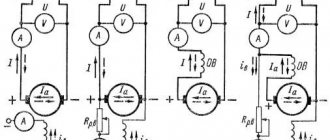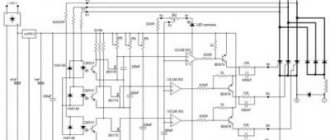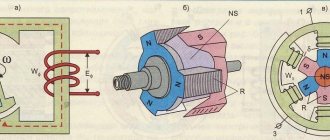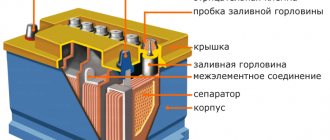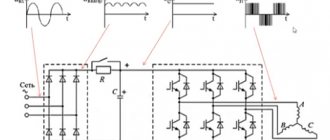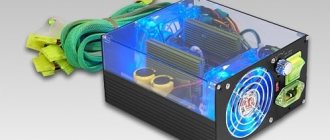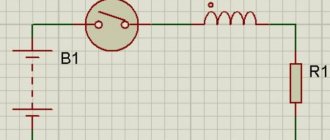For those who are unfamiliar with generators, we explain that this is a unit in which another type of energy is obtained from one type of energy. Or, more precisely, from mechanical to electrical. Moreover, these devices can generate both direct current and alternating current. Until the mid-twentieth century, mainly direct current generators were used. These were large devices that did not work very well. The appearance of semiconductor-type diodes on the market made it possible to invent a three-phase alternating current generator. It is diodes that allow alternating current to be rectified.
Three-phase generator device
In principle, the design of a three-phase alternating current generator is quite simple. This is a housing with two covers on opposite sides. Each of them has holes for ventilation. The covers contain niches for bearings in which the shaft rotates. A transmission element is installed on the front end of the shaft. For example, a car generator has a pulley that transmits rotation from the internal combustion engine to the generator. At the opposite end of the shaft, electric current is transmitted, because the shaft in this case acts as an electromagnet with one winding.
The transmission is carried out through graphite brushes and slip rings (they are made of copper). The brushes are connected to an electrical regulator (essentially a regular relay), which regulates the supply of 12 volts with the required deviations
The most important thing is that the relay does not increase or decrease the voltage depending on the speed of rotation of the shaft itself
So, if we talk about three-phase alternating current generators, then these are three single-phase ones. Only a three-phase unit has a winding not on the rotor (shaft), but in the stator. And there are three such windings, which are shifted relative to each other in phase. The shaft, as in the first design, performs the functions of an electromagnet, which is powered by direct current through sliding contacts.
The rotation of the shaft creates a magnetic field in the windings. Electromotive force begins to be induced when the magnetic field of the windings intersects with the rotor. And since the windings are located symmetrically on the stator, that is, every 120º, then, accordingly, the electromotive force will have the same amplitude value.
Story
Electrical machines generating alternating current have been known in a simple form since the discovery of magnetic induction of electric current. Early machines were designed by Michael Faraday and Hippolyte Pixie.
Faraday developed a "rotating rectangle" whose action was multipolar
- each active conductor was passed sequentially through an area where the magnetic field was in opposite directions. The first public demonstration of the most powerful "alternator system" took place in 1886. The large two-phase alternating current generator was built by British electrician James Edward Henry Gordon in 1882. Lord Kelvin and Sebastian Ferranti also developed an early alternator that produced alternating current with a frequency between 100 and 300 hertz. In 1891, Nikola Tesla patented a practical "high frequency" alternator (which operated at a frequency of about 15,000 hertz). After 1891, multiphase alternators were invented. A three-phase current generator with a three-wire load was proposed by the Russian engineer Dolivo-Dobrovolsky, who in 1903 built the world's first industrial three-phase power plant, which powered the Novorossiysk grain elevator.
Tags: beat, sconce, view, excitation, choice, switch, generator, engine, house, , capacity, grounding, insulation, like, computer, capacitor, , magnet, power, load, voltage, neutral, nominal, lighting, soldering iron , skew, variable, periodicity, constant, rule, principle, wire, manufacturer, start, vacuum cleaner, , work, size, calculation, regulator, relay, relay regulator, switch, row, light, network, system, connection, means, term , stabilizer, circuit, ten, type, current, transformer, triangle, three-phase, , phase, electricity, armature
How to choose?
When purchasing, first of all, focus on the conditions in which the generator will operate.
First, determine the required power. It must exceed the total power of simultaneously switched on consumers. It is recommended to have a small (or large) supply in case of emergency.
Select fuel type. Decide what is more important to you - efficiency or the ability to start in any conditions.
If congestion is possible in the network, you need to buy a synchronous model. But keep in mind that it will require more careful maintenance than asynchronous and has a shorter service life. Yes, and you will have to spend money on a security system. If overloads are completely excluded, an asynchronous generator would be the best choice.
Then check the workmanship.
- Turn the rotor by hand. It should rotate easily. Crunching, clicking and jerking in the bearings is not allowed, as is the beating of the rotor. It should not wobble in the bearings.
- Contacts and terminals should be shiny. Broken threads are not allowed. If there are wires, their reliable insulation is required. Especially at joints and bends.
- There should be no cracks on the stator and frame. Carefully inspect the support part.
- Check generator operation. The readings of the measuring equipment must be stable. The exhaust sound must be smooth.
- Responsible manufacturers carefully paint the product and attach the logo well. If the paint is in doubt, it is better to refuse such a generator.
- The credibility of any company is determined by the quality of service. Make sure that if a problem occurs, you can find a professional to fix it.
Then look for additional features
- It would be good if measuring instruments were already installed at the factory.
- It is better to buy models that have both a manual start and a starter.
- Check the ease of transportation. If there are wheels, they should spin well. If there are handles, they should be comfortable to hold.
And don’t be afraid to ask questions to consultants, even, in their opinion, ridiculous ones. The time you spend choosing is more than compensated for by trouble-free operation.
Selection of electric generator
A home power plant consists of an internal combustion engine and a rotating generator that produces electricity. The most common are four-stroke models with a maximum speed of 3 thousand revolutions. The volume of the fuel tank in domestic models is 10-15 liters. The main selection criterion should be the area of use. Generators can act as the main source of energy, but more often they are a reserve in an emergency.
When choosing, you should pay attention to some parameters:
- motor resource;
- power;
- efficiency;
- convenience.
When connecting, it is important to ensure the coordinated operation of 3 elements:
- home network - consumer;
- centralized supply chain;
- cable from the reserve.
Before connecting, determine the following points:
- safe and economical location of the electric generator;
- frequency of power failures in the general network, need for automation;
- calculated power consumption taking into account reserve and losses.
A suitable connection diagram must be provided.
A continuous supply of energy is quite expensive; a private home rarely needs such provision. Important consumers of electricity, such as a computer, can be connected to an uninterruptible power supply.
First of all, it is necessary to calculate the power of energy consumed. It is the sum of the load capacities that are planned to be connected. Additionally, a margin of 30% of the total value is added. This is required to take into account the starting currents of motors of household appliances, which are 2-3 times higher than permissible. You can select a unit based on its estimated power.
Calculation example. The house has a washing machine 2 kW, refrigerator – 0.5 kW, electric stove – 3 kW, general lighting – 0.5 kW, TV and computer – 0.5 kW. The total power is 6.5 kW, but when taking into account the reserve, the calculated value will increase to 8.5 kW.
The connection diagram for a gasoline generator to the home network should be as simple as possible. The main thing is that it is correct and allows the unit to be provided with the required load.
Principle of operation
The operating principle of three-phase generators is based on the law of electromagnetic induction. It states: an electromotive force (EMF) will be induced at the ends of a metal frame placed in a rotating magnetic field. In this case, both the frame itself and the magnets can rotate.
This is how demo models are designed. In real generators, instead of a frame, a coil of thin copper wire with conductors insulated from each other is used. This is done to increase the efficiency of the installation.
In modern models of 3-phase generators, the rotor acts as a magnet. In this case, the magnet can be permanent or electric. In the latter case, sliding contact with graphite brushes is used to power the rotor. To run such a device you need a separate source of electricity.
The power winding is located in the stator. This eliminates the need to transmit large currents through the sliding contact and improves operational reliability.
Rating of TOP 8 best models
| Place | Name | Price |
| TOP 5 best three-phase generators | ||
| 1 | Huter DY8000LX-3 | 40 000 ₽ |
| 2 | Daewoo Power Products GDA 7500DPE-3 | 59 000 ₽ |
| 3 | DDE DPG10553E | 74 000 ₽ |
| 4 | Daewoo Power Products GDA 7500E-3 | 55 000 ₽ |
| 5 | Hyundai HHY 10000FE-3 ATS | 59 000 ₽ |
| TOP 3 best three-phase generators with auto start | ||
| 1 | Hyundai HHY 10000FE-3 ATS | 59 000 ₽ |
| 2 | Daewoo Power Products GDA 8500E-3 | 59 000 ₽ |
| 3 | Hyundai HY12000LE-3 | 189 000 ₽ |
Kinds
3-phase alternating current generators do not differ greatly from each other. They differ only in power and design features.
According to the power of the generated current they are:
- 5 kW;
- 6 kW;
- 10 kW;
- 12 kW;
- 15 kW or more.
In addition, the actual power output depends on many factors, such as the quality and purity of the fuel, the state of the atmosphere (in cold and high humidity, power decreases) and the like.
Depending on the type of fuel used, generators are:
- diesel;
- gasoline;
- powered by wood or natural gas.
The first 2 options are most widespread. At the same time, diesel engines, due to their design, are more reliable because they operate without an ignition system. They are also more economical. Gasoline cars, in turn, are easier to start in difficult conditions.
According to the principle of operation, generators are either synchronous or asynchronous.
Synchronous. Their advantage is that they can withstand short-term overload by 5-6 times. This happens when starting some types of electric motors and other powerful equipment, when the starting currents significantly exceed the rated ones. But they have disadvantages - these are large dimensions and weight, as well as lower reliability compared to their asynchronous counterparts.
Generators may also have additional functions:
- the ability to connect additional lines to increase load capacity;
- adjusting the characteristics of the output current (for example, its shape);
- the presence of an electromagnetic relay-regulator.
According to their intended purpose, generators are:
- basic;
- auxiliary.
They differ only in the connection method.
That's all for the classification of generators. Now let's talk about choosing this device.
Steam turbine generator
The steam turbogenerator has increased reliability of its operation, while developing its design power continuously over many hours of operation. Such modern devices can have a power of up to 1300 MW. Often, steam turbine generators can operate in parallel. In this case, power can be transferred into one electrical circuit.
The thermal efficiency of a power plant in which a steam turbogenerator is installed directly depends on the types and parameters of the thermal cycle of using the heat of the generated steam, as well as on the equipment itself and its characteristics.
Often, a low-power steam turbine turbine generator is installed in industrial boiler houses where fuel oil or solid fuel is used. Turbines here function as throttling devices for reduction-cooling units, based on the difference in pressure from the boiler to the industrial extraction or heat exchanger. /p>
The power of the turbogenerator operating in this industry ranges from 250 kilowatts to 5 megawatts. This installation allows you to obtain very cheap electrical energy. It turns out to be eight times cheaper than purchased. And all equipment, when operating more than 5,000 hours a year, can quickly pay for itself within three years.
The steam turbine of a small-load turbogenerator can be used not only as a drive for an electric generator, but also to drive devices necessary for the operation of boiler houses for any purpose.
Connection diagrams
The main task when connecting to an existing power grid is to prevent the generated current from “meeting” and coming from the power plant. Otherwise the consequences will be disastrous.
To solve this problem, there are several methods for connecting the generator to the electrical network.
Through a socket
The simplest method. Consumers are connected to the generator directly. But there are serious disadvantages:
- complete lack of protective devices;
- you need to buy a special 4-pole socket designed for high current.
This method is strongly not recommended. We wrote about it only because it exists.
Through a distribution machine
This is a more convenient method because it does not require changes to the existing electrical network. It has proven itself especially well in private homes.
To connect, do the following.
- Turn off the input circuit breaker of the centralized power distribution system. Simply put, cut off the power in the house.
- Install a new 4-pole circuit breaker in the panel. Connect its output contacts to your home network.
- Carefully connect the cable from the generator to the new machine. All wires are connected to the corresponding terminals.
Through the switch
The main disadvantage of the previous scheme is the possibility of mains voltage reaching the generator. This can happen if the switches are not used carefully. To prevent this from happening, the generator can be connected through a switch.
This connection completely eliminates the possibility of a short circuit. The switch has 3 contacts:
- the first is powering consumers from a centralized network;
- third – power supply from a generator;
- central - the network is completely de-energized.
Consumers are connected to the central contact.
After the switch, fuses, RCDs and other protective equipment must be installed.
The main generators are connected in this way.
Automatic activation system
The main disadvantage of all these methods is manual control. And sometimes you need the generator to start automatically (especially in emergency situations). In these cases, an automatic switching system is used.
It includes 2 crossover starters and a control module. When there is a power outage, they disconnect consumers from the centralized system and connect them to a generator.
Regardless of the connection method, never forget to ground the generator frame. And most importantly: switching devices, switches and fuses are prohibited from being placed in the grounding wire. This will protect against accidents and guarantee the safe operation of the device.
To find out which generator to buy: single-phase or three-phase, see below.
We do not recommend:
- Ground one of the generator outputs to the common house PE bus (ground). If your ground “falls off” (a wire rots or a connection comes loose), dangerous voltage will appear on all grounded appliances in your home.
- Connect budget generators directly to the load without using network interference filters. Changing the generator speed causes strong interference and voltage surges, which are dangerous for sensitive electronic equipment (automatic gas boilers, expensive household appliances).
- Use three-phase generators with a power of up to 10 kW for backup power at home. Phase imbalance will lead to rapid failure of the generator. Use single-phase generators with a phase combination circuit.
- Connect inverter generators to a common neutral bus. This can lead to rapid generator failure.
- Neglect the rule of grounding the generator housing itself.
- Use a non-inverter generator without a solidly grounded neutral of one of its outputs, because this leads to incorrect operation of differential protection devices (RCDs) and errors in the operation of phase-dependent boilers.
- Use the generator output for grounding, which is turned off by a single-pole circuit breaker on its body.
We’ll talk about how to properly connect a generator to the network (220/380V) of a country house later.
Principle of operation
The operation of a three-phase generator is based on Faraday's law - the law of electromagnetic induction, which states that an electromotive force will necessarily be induced in a rotating rectangular frame, which is installed between two magnets. The caveat is that the magnets will create a rotating magnetic field. The direction of rotation of both the frame and the magnetic field must coincide. But an electromotive force will also arise if the frame remains stationary and the magnet rotates inside it.
To understand how the generator works, pay attention to the figure below. This is the simplest way it works
Here you can clearly see magnets with different poles, a frame, a shaft and slip rings, with the help of which current is drained.
Of course, this is just a diagram, although laboratory generators were created this way. In practice, ordinary magnets are replaced by electromagnets. The latter are copper windings or inductors. When an electric current passes through them, the necessary magnetic field is formed. Such generators are installed in all cars (this is just an example); to start them, a battery is installed under the hood, that is, a direct current source. Some generator models are started using the principle of self-excitation or using low-power generators.
Alternator circuit
Varieties
The classification is based on the principle of operation, therefore these AC units are divided into two classes:
- Asynchronous. These are the most reliable generators, small in size and weight, simple in design. They cope well with overloads and short circuits. However, it is necessary to take into account that this type will immediately fail if it is subject to a large overload. For example, the starting current of electrical equipment. Therefore, it is worth taking this fact into account, for which you will have to purchase a generator with a power three or four times greater than the power consumed by the equipment at startup.
- Synchronous. But this type easily copes with short-term loads. Such a generator can withstand an overload of five or six times. True, it does not differ in high reliability compared to asynchronous options; moreover, it is large in size and weight.
Of course, this division is based on the operating principle of the unit. But there are other criteria.
- Single phase.
- Two-phase.
- Three-phase.
- Multiphase (usually six phases).
- Welding.
- Linear.
- Induction.
- Stationary.
- Portable.
Theoretical part
The basic principle of operation of an alternator
Let's start with the most basic - alternating current differs from direct current in that it changes its direction of movement with some frequency. It also changes the value, which we will talk about in more detail later.
After a certain period of time, which we will call “T”, the values of the current parameters are repeated, which can be depicted on the graph as a sinusoid - a wavy line passing with the same amplitude through the central line.
Basic principles
So, the purpose and design of alternating current generators, previously called an alternator, is to convert kinetic energy, that is, mechanical, into electrical energy. The vast majority of modern generators use a rotating magnetic field.
- Such devices operate due to electromagnetic induction, when when a coil of conductive material (usually copper wire) rotates in a magnetic field, an electromotive force (EMF) arises in it.
- The current begins to form at the moment when the conductors begin to cross the magnetic lines of the force field.
The structure of the simplest electromagnetic generator
Moreover, the peak value of the EMF in the conductor is achieved when it passes the main poles of the magnetic field. At those moments when they slide along the lines of force, induction does not occur and the emf drops to zero. Take a look at any of the diagrams presented - the first state will be observed when the frame takes a vertical position, and the second - when it is horizontal.
Alternating current generator - how it works
- To better understand the ongoing processes, you need to remember the rule of the right hand, studied by everyone in school, but few remember. Its essence lies in the fact that if you position your right hand so that the magnetic field lines enter it from the palm, the thumb moved to the side will indicate the direction of movement of the conductor, and the remaining fingers will indicate the direction of the EMF arising in it.
- Take a look at the diagram above, position "a". At this moment, the emf in the frame is zero. The arrows show the direction of its movement - part of frame A moves towards the north pole of the magnet, and B - towards the south, reaching which the EMF will be maximum. Applying the right-hand rule described above, we see that the current begins to flow in part “B” towards us, and in part “A” - away from us.
- The frame rotates further and the current in the circuit begins to fall until the frame again takes a horizontal position (c).
- Further rotation leads to the fact that the current begins to flow in the opposite direction, since parts of the frame have swapped places when compared with the initial position.
After half a revolution, everything will return to its original state and the cycle will repeat again. As a result, we found that during the complete revolution of the frame, the current increased twice to a maximum and dropped to zero, and once changed its direction relative to the initial movement.
Alternating current
The current frequency was named in his honor
It is generally accepted that the duration of the circulation period is 1 second, and the number of periods “T” is the frequency of the electric current. In standard electrical networks in Russia and Europe, in one second the current changes its direction 50 times - 50 periods per second.
In electronics, one such period is designated by a special unit, named after the German physicist G. Hertz. That is, in the given example of Russian networks, the current frequency is 50 hertz.
In general, alternating current has found very wide application in electronics due to the fact that: the magnitude of its voltage is very easy to change using transformers that do not have moving parts; it can always be converted to direct current; the design of such generators is much more reliable and simpler than for generating direct current.
The most powerful generators installed at the Pushkinskaya hydroelectric station
What is a phase
In physics, a phase is understood as one of the states of a substance (for example, water is in liquid, liquid-crystalline, crystalline and gaseous aggregate states). In addition, it refers to a stage in a cycle of oscillation (for example, in wave motion).
In astronomy, the word has a slightly different meaning. What a phase is in this science can be understood from observations of a celestial body (for example, the Moon) from Earth. That is, it can be designated as the visible part of the illuminated hemisphere of a celestial object from Earth.
In economic theory, it is widely known what cycle phases are. This is when in a certain period of time (cycle) regular activity is observed.
Let's look at what this term means in electricity.
Find the neutral wire in the apartment
According to the rules, the housing of the access panel is grounded. It is carried out using a solid-sized terminal, tightened with a powerful bolt in old-built houses; it will be easier for residents of modern buildings to navigate by the number of cores. The zero bus has the largest number of connections, the phases are separated into apartments (good electricians hang up stickers A, B, C; evil ones don’t). We can easily follow the layout of circuit breakers and meters.
230 volt UK plug
In each case, the common wire will be zero. Color does not play a decisive role. Although according to standards, modern cables are equipped with colored insulation
Please note - if the house is equipped with grounding, there will be at least 5 cores at the input. The panel body is mounted on a yellow-green
The neutral wire will serve to drain the operating current from the devices (closes the circuit). Merging branches on the consumer side is prohibited. Here are three rules to help you understand the entrance panel (please note, according to the rules, the tenant should not show his nose there at all - we have warned):
- The circuit breaker breaks the phase. There are two-pole models; they are used relatively rarely for rooms with particular danger (bathroom). Therefore, by the position of the wire you can tell: this is a phase. Then you can turn off the machine and ring the wire on the side of the apartment. It will definitely give the phase position.
- The voltage between the neutral wire and any phase is 230 volts. Based on the key characteristic, we will select a vein that gives the specified difference to another. The spread between phases is 400 volts. The percentage values are 10 percent higher; Russian networks are trying to meet European standards.
- We use current clamps to measure the values on the conductors. For each phase there will be a certain value, the sum of which (in three) should flow back to the network via zero (or a suitable phase). Grounding is rarely used; the current here will be close to zero if the branches are evenly loaded. The place where the value is greatest is traditionally the neutral conductor.
- The grounding terminal of the distribution board is visible. The sign will help you find the neutral wire in houses with NT-CS. In other cases, grounding is supplied here.
Wires
Let's understand what phase, ground and neutral wire are in more detail.
It's easy to imagine with a star connection. The phase connection point is called neutral.
Usually it is grounded to increase safety, since if the device fails, then in the absence of grounding, a danger will be created for humans. If you touch the device, it will simply give you an electric shock. But if there is grounding, excess current will leak and no risk will arise.
So, all together - the neutral wire, the ground and the phase of the wire are necessary to ensure the safety of people. New houses under construction have just such a system, while older ones do not have it.
Additional information about finding the ground, phase, neutral wire
Let's add another method - it is prohibited by industry. A light bulb in a socket with two exposed wires. Using the tool, the phase is found, and the wire can be short-circuited to ground. You cannot use water, gas, sewer pipes or other engineering structures. According to the rules, the cable antenna braid is equipped with grounding (grounding). With respect to it, you can use a tester (a light bulb in a socket prohibited by standards) to find the phase.
For determined people, we recommend fire escapes and steel tires for lightning rods. You need to clean the metal until it shines, call the phase phase
Please note that not all fire escapes are grounded (although they must be), lightning rod buses are 100%. If you discover such blatant arbitrariness, you can contact the management organizations; if there is no response, knock (Russians call human rights activists informers) to government agencies
Indicate a violation of the rules for protective grounding of buildings.
Advantages and disadvantages
Like everything material, three-phase current has its pros and cons. The positive aspects of using systems with three or four wires include:
- efficiency. To transmit electricity over long distances, cores made of non-ferrous metals with low resistivity are used. The voltage is divided proportionally to the number of cables. By distributing loads, engineers can reduce the number of wires and their cross-section, which, given the cost of rare materials, provides noticeable savings;
- efficiency. The power parameters of three-phase transformers are an order of magnitude higher than single-phase transformers with smaller magnetic core sizes;
